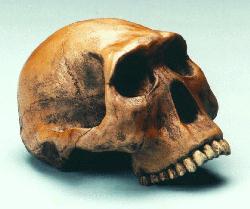| It is in Tanzania, Ethiopia, and South Africa that
the earliest fossils of the genus Homo come. They date from 1.9 to
1.6 million years ago. The first fossil finds of this genus
were of the species Homo habilis in the lowest level of the Olduvai
Gorge. This discovery was made by Louis Leakey and his co-workers.
The older specimens of the species bear a strong resemblance to Australopithecus
africanus and the younger ones to show more in common with Homo
erectus.
The differences between Homo habilis
and Australopithecus are: homo habilis possesses a greater cranial
capacity(610 to about 800cc), it has reduced prognathism- a flatter face
and a shorter tooth row. Homo habilis has limbs still reminiscent
of apes in terms of their relative proportions. It is believed ,
therefore, that Homo habilis was still a very good climber. |
Here is the skull of Homo habilis.

|
| Homo habilis is also thought to have possessed
a locomotion more human in attributes than that of the australopithecines.
Stone tools and cut animal bones have been found associated with Homo
habilis. Brain specialists see in casts made from habilis skulls
the bulge of Broca's area. This bulge was not found in earlier hominids. |
This region is essential to speach; and so it is believed
that habilis was probably equipped for rudimentary speach.
The giant increase in brain size made by habilis would have given
the species the advantage of stone tool-making. Tool-making also
leads to the beginning of culture. The best habilis
material
comes from Koobi Fora, on the east side of Lake Turkana in northern Kenya.
|
